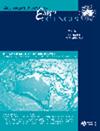变形辅助熔体迁移在海洋岩心复合体形成中的关键作用
IF 0.9
4区 地球科学
Q3 GEOSCIENCES, MULTIDISCIPLINARY
引用次数: 0
摘要
海洋岩心复合体为研究在缓慢和超缓慢扩张的洋中脊发生的深层过程提供了一个可接近的窗口。我们分析了来自亚特兰蒂斯滩、亚特兰蒂斯地块以及西南印度和中大西洋山脊凯恩变换附近的岩心复合体的IODP海洋钻探样本。我们把包括氧化物在内的次生矿物与熔体迁移地点联系起来。我们将矿物组合和微化学、反应结构和熔体-伪晶状微观结构的变化解释为开放系统熔体介导过程的指纹。这些微观尺度的信息与宏观尺度上遗留矿物化学数据的回顾相结合,表明在所研究的三个岩心杂岩中,熔融流体岩石具有非常相似的特征。它们富含氧化物,具有橄榄石、正辉石和斜辉石颗粒,在化学上与贫氧化物辉长岩不同。我们认为,有外部熔体的洋壳可以通过以下关键特征来识别:(1)氧化物和橄榄石等次生矿物的高模式;(2)熔体曾经存在的微观结构证据;(3)原生橄榄石和次生橄榄石、正辉石、斜辉石和斜长石的矿物化学差异。重要的是,以前只报道过橄榄石是原生的,也就是说,橄榄石是从岩浆中结晶出来的。然而,我们的研究结果表明,含次生橄榄石的辉长岩是在变形辅助下熔融体扩散迁移通过辉长岩洋壳过程中熔融岩相互作用的可靠指标。最后,我们提出了一种新的海洋岩心复合体形成模型,其中变形辅助熔体迁移在岩心复合体的应变定位、挖掘和演化中起着关键作用。本文章由计算机程序翻译,如有差异,请以英文原文为准。
The critical role of deformation-assisted melt migration in the formation of oceanic core complexes
Oceanic core complexes provide an accessible window into deep processes occurring at slow and ultra-slow-spreading mid-ocean ridges. We analyse samples from IODP ocean drilling of core complexes at the Atlantis Bank, Atlantis Massif, and near the Kane Transform at the South West Indian and Mid-Atlantic ridges. We correlate secondary minerals, including oxides, with sites of melt migration. We interpret changes to mineral assemblage and microchemistry, reaction textures and melt-pseudomorph microstructures as fingerprints of open-system melt-mediated processes. This micro-scale information is combined with a macro-scale review of legacy mineral chemistry data to show that melt-fluxed rocks share remarkably similar characteristics across the three core complexes investigated. These are rich in oxides and have olivine, orthopyroxene and clinopyroxene grains that are chemically distinct from oxide-poor gabbros. We propose that oceanic crust fluxed with external melt can be recognised by the following key features: (1) high modes of secondary minerals, such as oxides and olivine, (2) microstructural evidence for the former presence of melt, and (3) mineral chemistry differences between primary and secondary olivine, orthopyroxene, clinopyroxene and plagioclase. Importantly, olivine has previously only been reported as primary, that is, having crystallised from magma. However, our results show that gabbros with secondary olivine are reliable indictors of melt–rock interaction during deformation-assisted diffuse melt migration through the gabbroic oceanic crust. Finally, we propose a new model for the formation of oceanic core complexes where deformation-assisted melt migration plays a critical role in strain localisation, exhumation and evolution of the core complex.
求助全文
通过发布文献求助,成功后即可免费获取论文全文。
去求助
来源期刊

Australian Journal of Earth Sciences
地学-地球科学综合
CiteScore
2.80
自引率
8.30%
发文量
45
审稿时长
6-12 weeks
期刊介绍:
Australian Journal of Earth Sciences publishes peer-reviewed research papers as well as significant review articles of general interest to geoscientists. The Journal covers the whole field of earth science including basin studies, regional geophysical studies and metallogeny. There is usually a thematic issue each year featuring a selection of papers on a particular area of earth science. Shorter papers are encouraged and are given priority in publication. Critical discussion of recently published papers is also encouraged.
 求助内容:
求助内容: 应助结果提醒方式:
应助结果提醒方式:


